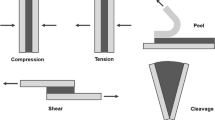Abstract
Composites of styrene butadiene rubber (SBR), hydrogenated acrylonitrile–butadiene rubber (HNBR) and silica were prepared. Sulfur (S), dicumyl peroxide (DCP) and a combination of S and DCP (M) were used as curing agents, respectively. The morphology of the composites with different blend ratio was examined to correlate with observations on mechanical properties by scanning electron microscopy. The effects of blend ratio and curing systems on the curing characteristics and mechanical properties, such as stress–strain behavior, tensile strength, elongation at break and hardness of SBR/HNBR/Silica composites, were studied. Composites prepared by M curing systems showed comparatively better mechanical properties, wet traction and rolling resistance than S and D curing systems. The tensile strength, tear strength, and elongation at break were improved by adding HNBR for M curing systems. The wet traction of the vulcanizates containing HNBR was better than that of the vulcanizates without HNBR. A relatively uniform dispersion of silica was observed for SBR/HNBR/silica compositions compared with SBR/silica composites.






Similar content being viewed by others
References
Heinrich G, Kluppel M, Vilgis TA (2002) Reinforcement of elastomers. Curr Opin Solid State Mater Sci 6:195–203
Suk GS, Kwang MP, Kyoung H, Chang TC, Shinyoung Kaang KH (2010) Effectively reinforcing roles of the networked silica prepared using 3,3′-bis(triethoxysilylpropyl)tetrasulfide in the physical properties of SBR compounds. J Mater Sci 45:1897–1903
Choi S-S, Nah C, Lee SG, Joo CW (2003) Effect of filler–filler interaction on rheological behaviour of natural rubber compounds filled with both carbon black and silica. Polym Int 52:23–28
Konečný P, Černý M, Voldánová J, Maláč J, Šimoník J (2007) Dynamic mechanical properties of filled styrene butadiene rubber compounds: comparison of tensile and shear data. Polym Adv Technol 18:122–127
Habeeb Rahiman K, Unnikrishnan G, Sujith A, Radhakrishnan CK (2005) Cure characteristics and mechanical properties of styrene–butadiene rubber/acrylonitrile butadiene rubber. Mater Lett 59:633–639
Botros SH, Younan AF, Essa MM (2000) Molecular crystals and liquid crystals science and technology. Mol Cryst Liq Cryst Sci Tech Sect A 354:409–420
Kumari P, Radhakrishnan CK, Unnikrishnan G, Varghese S, Sujith A (2010) Natural rubber/acrylonitrile butadiene rubber blend membranes: vapor permeation properties. Chem Eng Technol 33:97–102
Ghosh A, De SK (2004) Dependence of physical properties and process behavior of blends of silicone rubber and fluororubber on blend morphology. Rubber Chem Tech 77:856–872
Choi SS (2001) Improvement of properties of silica-filled styrene–butadiene rubber compounds using acrylonitrile–butadiene rubber. J Appl Polym Sci 79:1127–1133
Ramesan MT, Mathew G, Kuriakose B, Alex R (2001) Role of dichlorocarbene modified styrene butadiene rubber in compatibilisation of styrene butadiene rubber and chloroprene rubber blends. Eur Polym J 37:719–728
Noriman NZ, Ismail H (2011) The effects of electron beam irradiation on the thermal properties, fatigue life and natural weathering of styrene butadiene rubber/recycled acrylonitrile–butadiene rubber blends. Mater Des 32:3336–3346
Karger-Kocsisa J, Felhösc D, Xu D (2010) Mechanical and tribological properties of rubber blends composed of HNBR and in situ produced polyurethane. Wear 268:464–472
Likozar B, Major Z (2010) Morphology, mechanical, cross-linking, thermal, and tribological properties of nitrile and hydrogenated nitrile rubber/multi-walled carbon nanotubes composites prepared by melt compounding: the effect of acrylonitrile content and hydrogenation. Appl Surf Sci 257:565–573
Zhao W, Yu L, Zhong X, Zhang Y, Sun J (1994) Radiation vulcanization of hydrogenated acrylonitrile butadiene rubber (HNBR). J Appl Polym Sci 54:1199–1205
Giurginca M, Zaharescu T (2000) Thermal and radiation behaviour of HNBR and CSPE blends. Polymer 41:7583–7587
Gatos KG, Sawanis NS, Apostolov AA, Thomann R, Karger-Kocsis J (2004) Nanocomposite formation in Hydrogenated Nitrile Rubber (HNBR)/organo-montmorillonite as a function of the intercalant type. Macromol Mater Eng 289:1079–1086
Chen S, Haiyang Yu, Ren W, Zhang Y (2009) Thermal degradation behavior of hydrogenated nitrile-butadiene rubber (HNBR)/clay nanocomposite and HNBR/clay/carbon nanotubes nanocomposites. Thermochim Acta 491:103–108
Author information
Authors and Affiliations
Corresponding author
Rights and permissions
About this article
Cite this article
Changjie, Y., Zhang, Q., Junwei, G. et al. Cure characteristics and mechanical properties of styrene-butadiene rubber/hydrogenated acrylonitrile-butadiene rubber/silica composites. J Polym Res 18, 2487–2494 (2011). https://doi.org/10.1007/s10965-011-9670-y
Received:
Accepted:
Published:
Issue Date:
DOI: https://doi.org/10.1007/s10965-011-9670-y




